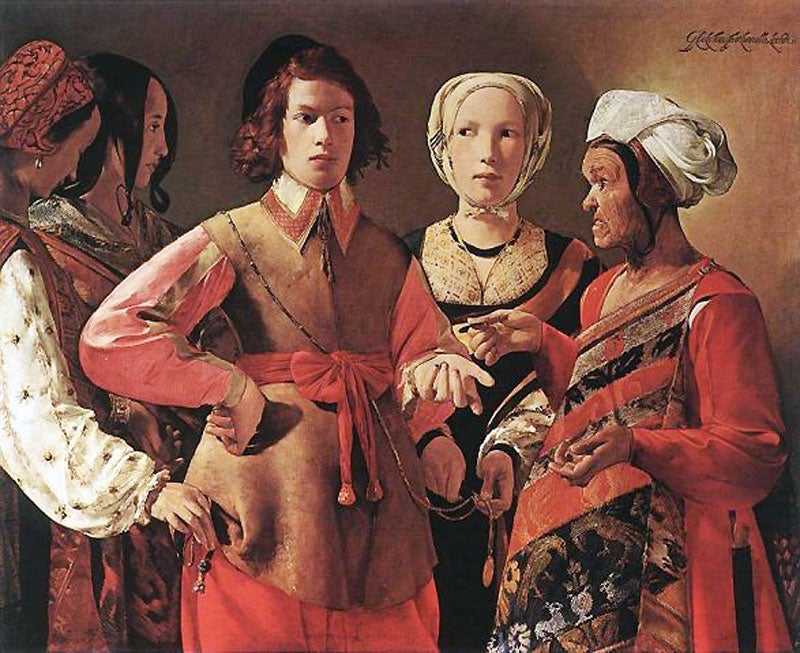de la Tour, Georges: The Fortune Teller (c1630)
The Independent's Great Art series

According to the novelist Umberto Eco, the Parisian writers' group OuLiPo (Ouvroir de Littérature Potentielle, or Workshop for Potential Literature) once constructed "a matrix of all possible murder-story situations, and found that there is still to be written a book in which the murderer is the reader". No surprise, perhaps. It would be hard for any whodunnit to implicate, in its fictional crime, the individual who happened to be reading it.
For a picture it is easier. Georges de La Tour is famous for his candlelit nocturnes, but The Fortune Teller is an image of daylight robbery. A fop is decoyed by having his palm read while three Gypsies are surreptitiously removing his valuables. What's going on behind his back is all before your eyes.
This painting was aptly used on the cover of a book called When Bad Things Happen to Other People, a study of schadenfreude. And you're certainly invited to take pleasure in the careful and graceful operation of this sting, as much as in the sumptuous rendering of the fabrics. But your view of things is not so detached. As you stand in front of this scene, you're made an accessory to its crime.
Consider the boy. He is undone especially by his propensity to pose. He has his gaze on the fortune-teller, but his attention is on the world out front. If he wasn't so conscious of being on view, he'd have more chance of seeing what was going on. Cutting a figure, with hand lightly on hip, it's as if he has made a mistake about what kind of picture he's in. The Fortune Teller is like a formal portrait – with added thieves.
Maybe his problem is partly embarrassment. An unworldly fop, surrounded by all this strange female attention, he is frozen by social/sexual awkwardness. (The interfering fingers, entering his pocket, handling his pendant, introduce a sexual subplot.) Either way, he strikes a pose, specifically to you, the viewer. You're his audience. You're not just a casual bystander-witness to a crime. You play the role of additional decoy for its unwitting victim.
Or consider the girl who clips off the boy's medallion. Her sharp eyes-right, combined with her straight face-front, is the most striking gesture of the scene. She could be shooting a glance to her accomplice. She could be keeping a careful eye on her prey. But in either case, why does she keep her face so firmly turned to the front?
The whole scene is on tenterhooks and hugger-mugger. The slightest nudge, or noise, or visible motion, will give the game away. The boy might turn round at any point. Even now, he can probably register, out of the corner of his eye, the girl's stance. It's important she gives him no cause for suspicion. Her face-front is a tactic, the position from which she can monitor her hands, her victim, her assistant, with eye movements only, no risky head movements.
The face-front is also a blind. It gives the boy the impression that she's looking in the same direction as she's facing – out at the viewer. It is the innocent direction in which to look. You're what she pretends to be interested in while otherwise occupied – and if he turns, that's where he'll find her looking. You are the alibi for her attention.
The viewer is not the doer of the crime, no. But you're implicated. You're inescapably put in the position of someone who's both a handy distraction for its victim, and a handy pretext for its perpetrator. You're an essential player in this theatre of complicity.
The artist
Georges de La Tour (1593-1652) is a shadowy figure. Not much is known of his life.He worked in the Lorraine region of France, and somehow picked up the influence of Caravaggio. He first painted daylight scenes of mainly lowlife characters, then dramatic candlelit religious scenes. His observational techniques are miraculous, his scene-setting brilliant. Like Caravaggio and Vermeer, he fell into obscurity until the late 19th century. There's no certain likeness of him, but his signature, is most elaborate (see top right corner, above). The work is on loan to the Walker Art Gallery, Liverpool, for another week.
Subscribe to Independent Premium to bookmark this article
Want to bookmark your favourite articles and stories to read or reference later? Start your Independent Premium subscription today.

Join our commenting forum
Join thought-provoking conversations, follow other Independent readers and see their replies